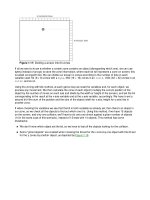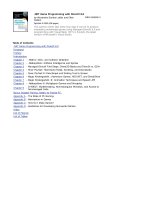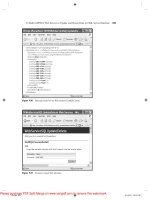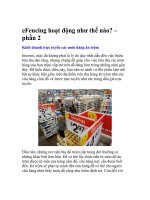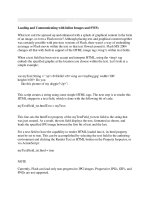Tài liệu ANALOG BEHAVIORAL MODELING WITH THE VERILOG-A LANGUAGE- P3 doc
Bạn đang xem bản rút gọn của tài liệu. Xem và tải ngay bản đầy đủ của tài liệu tại đây (1.08 MB, 30 trang )
Statements for Behavioral Descriptions
else
V(out) <+ 0.0;
for the variable x as some arbitrary function of time, is discontinuous at the output
about the condition x == 2.5 for V(out), in both time and value. This may or
may not be a problem, depending upon the type of network to which the output sig-
nal, V(out) is attached. For resistive loads, these types of discontinuities do not
present problems. However, for capacitive or inductive loads, this type of behavior
will potentially cause problems for the simulation. The Verilog-A language provides
capabilities for the model developer to effectively handle such cases but still relies on
the developer for recognizing and utilizing these capabilities.
The mathematical validity and stability of the formulation of a model are important
issues to consider when developing a behavioral model, particularly during the test
and validation of the model.
3.3 Statements for Behavioral Descriptions
In the Verilog-A language, all analog behavior descriptions are encapsulated within
the analog statement. The analog statement encompasses the contribution state-
ment(s) that are used to define the relationships between the input and output signals
of the module. Statements within the Verilog-A language allows these contribution
statements used in defining the analog behaviors to be sensitive to procedural and/or
timing control.
This section describes the statements used in formulating analog behavioral descrip-
tions.
3.3.1 Analog Statement
The analog statement is used for defining the behavior of the model in terms of con-
tribution statements, control-flow, and/or analog event statements. All the state-
ment(s) comprising the analog statement are evaluated at each point during an
analysis. The analog statement is the keyword analog followed by a valid Ver-
ilog-A statement.
Behavioral Descriptions
45
Please purchase PDF Split-Merge on www.verypdf.com to remove this watermark.
Behavioral Descriptions
analog
<statement>
Where <statement> is a single statement in the Verilog-A language as in the module
resistor of Listing 3.1.
LISTING 3.1
Resistor module illustrating a single statement attached to the
analog statement.
module resistor(p, n);
inout p, n;
electrical p, n;
parameter real res = 1.0;
analog
V(p, n) <+ res*I(p, n);
endmodule
The statement attached to an analog statement is usually a block statement delim-
ited by a begin
-
end pair.
analog begin
<statements>
end
The block or compound statement defines the behavior of the module as a procedural
sequence of statements. The block statement is a means of grouping two or more
statements together so that they act syntactically like a single statement. For example,
the module resistor of Listing 3.1 could be re-written using a block statement as
in Listing 3.2.
LISTING 3.2
Resistor module illustrating a block statement attached to the
analog statement.
module resistor(p, n);
inout p, n;
electrical p, n;
parameter real res = 1.0;
real volts;
46
Verilog-A HDL
Please purchase PDF Split-Merge on www.verypdf.com to remove this watermark.
Statements for Behavioral Descriptions
analog begin
volts = res*I(p, n);
V(p, n) <+ volts;
end
endmodule
The group of statements within the analog block are processed sequentially in the
given order and at each timepoint during a transient simulation. This aspect of the
Verilog-A language allows the module developer the ability to define the flow of con-
trol within the behavioral description
1
.
Statements of any block statement are guaranteed to be evaluated if the block state-
ment is evaluated. This property, in conjunction with properties of analog behaviors
described in the Verilog-A language to be discussed in Section 3.4, has implications
in the formulation of the analog behaviors for stability and robustness.
3.3.2 Contribution Statements
The contribution statements within the analog block of a module form the basis of
the behavioral descriptions used to compute flow and potential values for the signals
comprising the analog system. The behavioral or large-signal description is the math-
ematical relationships of the input signals to output signals. In the probe-source
model described in Section 2.6, the relationships between input and output signals is
done with contribution statements of the form:
output_signal <+ f(input_signals);
Where output_signal is a branch potential or flow source that is the target of the
contribution operator (<+) assigned by the value of the right-hand side expression,
f (input_signals). For example,
V(pout1, nout1) <+ expr1;
I(pout2, nout2) <+ expr2;
1.
The evaluation of the entire group of statements within the analog block at every time-
point is a departure from the semantics of the always statement in digital Verilog. In digital
Verilog, the evaluation of the behavioral model is determined by monitoring and blocking on
events of the (digital) signals.
Behavioral Descriptions
47
Please purchase PDF Split-Merge on www.verypdf.com to remove this watermark.
Behavioral Descriptions
are examples of potential and flow branch contributions respectively. The right-hand
side expressions, expr1 and expr2, can be any combination of linear, nonlinear,
algebraic, or differential expressions of module signals, constants and parameters.
A contribution statement is formed such that the output is isolated
1
. For example,
given the following transfer function for H(s) :
the transfer function relationship can be formulated in terms of the output, y(t), for
the large-signal response as,
from which, the behavioral relationship can be expressed in the Verilog-A language
contribution statement as
V(y) <+ ddt(V(y))/R + V(x);
Where
V(y)
, the potential of the signal
y,
or y(t) and
V(x)
is the potential of the
signal
x
, or x(t). Note that Only a potential or flow source branch can be the target of
a contribution operator, i.e., no real or integer variables.
3.3.3 Procedural or Variable Assignments
In the Verilog-A language, branch contributions and indirect branch contributions
2
are used for modifying signals. The procedural assignments are used for modifying
integer and real variables. A procedural assignment in the Verilog-A language is sim-
ilar to that in any programming language:
1.
The probe-source formulation does not require that the output cannot also appear on the
right-hand side of the contribution operator. In addition, an alternative equation formulation
construct is presented in Section 3.6.2 for such cases when it is not easy to isolate the output.
2. Described later in section 3.6.
48
Verilog-A HDL
Please purchase PDF Split-Merge on www.verypdf.com to remove this watermark.
Statements for Behavioral Descriptions
real
x;
real y[1:12];
analog begin
In general, the left-hand side of the assignment must be an integer or a real identifier
or a component of an integer or real array. The right-hand side expression can be any
arbitrary expression constituted from legal operands and operators in the Verilog-A
language.
3.3.4 Conditional Statements and Expressions
The Verilog-A supports two primary methods of altering control-flow within the
behavioral description of a module which are the conditional statement and the ter-
nary or
?:
operator. The control-flow constructs within the Verilog-A language are
used for defining piece-wise behaviors (linear or nonlinear). The conditional state-
ment
(or
if-else
statement)
is
used
to
make
a
decision
as to
whether
a
statement
is
executed or not. The syntax of a conditional statement is as follows:
if ( expr )
<statement>
else
<statement>
where
the
else
branch
of the
if-else
statement
is
optional.
If the
expression eval-
uates to true (that is, has a non-zero value), the first statement will be executed. If it
evaluates to false (has a zero value), the first statement will not be executed. If there is
an
else
statement
and
expression
is
false,
the
else
statement
will
be
executed.
As
previously
described,
the
if-else
statement
can be
used
to
define
an
analog
behavior that determines the maximum of two input signals (or values) as in Listing
3.3.
LISTING
3
.3
Module
definition
illustrating
use of
if-else
statements.
Behavioral Descriptions
49
x =
5.0;
y[i] = x;
end
···
Please purchase PDF Split-Merge on www.verypdf.com to remove this watermark.
Behavioral Descriptions
module maximum(out, in1, in2);
inout out, in1, in2;
electrical out, in1, in2;
real vout;
analog begin
if (V(in1) > V(in2))
vout = V(in1);
else
vout = V(in2);
V(out) <+ vout;
end
endmodule
Because the else <statement> part of an if-else is optional, there can be con-
fusion when an else is omitted from a nested if sequence. This is resolved by always
associating the else with the closest previous if that lacks an else. In Listing 3.4,
the else goes with the inner if, as shown by indentation.
LISTING 3.4
Proper association of else <statement> within a nested if.
if ( expr1 )
if ( expr2 )
<statement2a>
else
<statement2b>
If that association is not desired, a begin-end block statement must be used to force
the proper association, as shown in Listing 3.5.
LISTING 3.5 Forced association of an else <statement> using a block
statement.
if ( expr1 ) begin
if ( expr2 )
<statement2>
end else
<statement1b>
50
Verilog-A HDL
Please purchase PDF Split-Merge on www.verypdf.com to remove this watermark.
Statements for Behavioral Descriptions
The ternary operator
(
?:
)
can be used in place of the if statement when one of two
values is to be selected for assignment. The general form of the expression is:
conditional_expr ? expr1 : expr2
If the conditional_expr is non-zero, then the value of the ternary expression is
expr1, else the value is expr2. The maximum module definition of Listing 3.3 can
be written much more compactly using the ternary operator as in Listing 3.6.
LISTING 3.6
Module definition illustrating use of ternary operator.
module maximum(out, in1, in2);
inout out, in1, in2;
electrical out, in1, in2;
analog
V(out) <+ ((V(in1) > V(in2)) ? V(in1) : V(in2));
endmodule
The distinction between the if
-
else and the ternary operator is that the ternary
operator can appear anywhere an expression is valid in the Verilog-A language. Con-
versely, the if
-
else statement can only appear in the body of an analog or a
block statement.
3.3.5 Multi-way Branching
The Verilog language provides two ways of creating multi-way branches in behav-
ioral descriptions; the if-else-if and the case statements. The most general way
of writing a multi-way decision in Verilog-A is with an if-else-if construct as
illustrated in Listing 3.7.
LISTING 3.7
Multi-way branching using the if-else-if statement construct.
if ( expr1 )
<statement1>
else if ( expr2 )
<statement2>
else
<statement3>
Behavioral Descriptions
51
Please purchase PDF Split-Merge on www.verypdf.com to remove this watermark.
Behavioral Descriptions
The expressions are evaluated in order; if any of the expressions are true
(
expr1
,
expr2), the statement associated with it will be executed, and this will terminate the
whole chain. Each statement is either a single statement or a sequential block of state-
ments. The last else part of the if-else-if construct handles the none-of-the-
above or default case where none of the other conditions are satisfied. Sometimes
there is no explicit action for the default; in that case, the trailing else statement can
be omitted or it can be used for error checking to catch an unexpected condition.
For example, the behavior of a dead-band amplifier (Figure 3.3) using the if-else-
if construct, the behavior can be represented in the Verilog-A language as in Listing
3.8.
LISTING 3.8
Dead-band
amplifier
behavior using
the
if-else-if
statement
construct.
analog begin
if (V(in) >= db_high)
vout = gain*(V(in) - db_high);
else if (V(in) <= db_low)
vout = gain*(V(in) + db_low);
else
vout = 0.0;
V(out) <+ vout;
end
52
Verilog-A HDL
Please purchase PDF Split-Merge on www.verypdf.com to remove this watermark.
Analog Operators
Note that the variable vout, will be piece-wise continuous in value across the range
of V(in).
3.4 Analog Operators
Analog operators in the Verilog-A language are used for formulating the large-signal
behavioral descriptions of modules. Used in conjunction with the standard mathemat-
ical and transcendental functions (Appendix A), with analog operators the modeler
can define the components constitutive behavior. Similar to functions, analog opera-
tors take an expression as input and return a value. However, analog operators differ
in that they maintain internal state and their output is a function of both the current
input and this internal state.
The Verilog-A language defines analog operators for:
Time derivative
Time integral
Linear time delay
Discrete waveform filters
Continuous waveform filters
Laplace transform filters
Z-transform filters
3.4.1 Time Derivative Operator
The ddt operator computes the time derivative of its argument.
53
Behavioral Descriptions
Please purchase PDF Split-Merge on www.verypdf.com to remove this watermark.
Behavioral Descriptions
In DC analysis, ddt returns zero. Application of the ddt operator results in a zero at
the origin. Consider the example module definition of Listing 3.9 taking the time
derivative of the input signal.
LISTING 3.9 ddt analog operator example.
module ddt_op(out, in);
inout out, in;
electrical out, in;
parameter real scale = 1.0e-6;
analog
V(out) <+ scale*ddt(V(in));
endmodule
The results of applying a 100KHz sinusoidal signal, with amplitude of 1.0V, to the in
signal of the module, with scale set to its default value of 1.0e-6 are shown in Fig-
ure
3.5.
It is important to consider the input signal characteristics when doing when using the
ddt
operator
(as with all analog operators). Without setting the parameter scale to
1.0e-6, the output of the module would have been 6.28e6 volts with the same input
54
Verilog-A HDL
Please purchase PDF Split-Merge on www.verypdf.com to remove this watermark.
Analog Operators
signal applied. The model developer should be aware that when differentiating an
unknown input signal, a fast varying ‘noise’ component can dominate the true deriva-
tive of the signal of interest.
3.4.2 Time Integral Operator
The idt operator computes the time-integral of its argument.
idt(expr, ic, reset)
When specified with initial conditions, the idt operator returns the value of the ini-
tial condition in DC. Without initial conditions, idt multiplies it’s argument by infin-
ity in DC analysis. Hence, without initial conditions, idt must be used in a system
description with feedback that forces its argument to zero
1
. The optional argument
reset allows resetting of the integrator to the initial condition or
ic
value. Applica-
tion of the idt operator results in a pole at the origin.
The module definition of Listing 3.10 illustrates the use of idt operators with differ-
ent values of initial conditions specified.
LISTING 3.10
idt
analog operator example.
module idt_op(out1, out2, in);
inout out1, out2, in;
electrical out1, out2, in;
parameter real scale = 1.0e6;
analog begin
V(out1) <+ idt(scale*V(in), 0.0);
1.
Failure to do so will result in a system description that is not solvable - i.e., convergence will
not likely be achieved.
Behavioral Descriptions
55
Please purchase PDF Split-Merge on www.verypdf.com to remove this watermark.
Behavioral Descriptions
V(out2) <+ idt(scale*V(in), 2.0);
end
endmodule
The results of applying V(in) as a clock with a pulse period of 50n to the input of
the module of Listing 3.10 which differ only in the initial condition parameter
ic
(0.0
and 2.0), are shown in Figure 3.7. Both integrator modules were applied scale
parameter values of 1.0e6.
56
Verilog-A HDL
Please purchase PDF Split-Merge on www.verypdf.com to remove this watermark.
Analog Operators
3.4.3 Delay Operator
The delay operator implements a transport, or linear time delay for continuous
waveforms (similar to a transmission line).
The parameter dt must be nonnegative and any changes to the parameter dt are
ignored during simulation (the initially specified value for
dt
is used). The effect of
the delay operator in the time domain is to provide a direct time-translation of the
input. An example of the delay analog operator is illustrated in Listing 3.11.
LISTING 3.11
delay
analog
operator
example.
module delay_op(out, in);
inout out, in;
electrical out, in;
analog
V(out) <+ delay(V(in), 50n);
endmodule
Behavioral Descriptions
57
Please purchase PDF Split-Merge on www.verypdf.com to remove this watermark.
Behavioral Descriptions
The results of applying a signal
V(in)
(two-tone sinusoidal) to the input of the mod-
ule of Listing 3.11 is shown in Figure 3.9. For AC small-signal analysis, the delay
operator introduces a
phase shift.
3.4.4 Transition Operator
The
transition
operator smooths
out
piece-wise constant waveforms.
The
transition
filter is used to imitate transitions and delays on discrete signals.
58
Verilog-A HDL
Please purchase PDF Split-Merge on www.verypdf.com to remove this watermark.
Analog Operators
The input expr to the transition operator must be defined in terms of discrete
states
1
. The parameters dt, tr, and tf are optional to the transition analog
operator. If dt is not specified, it is taken to be zero. If only the tr value is specified,
the simulator uses it for both rise and fall times. In DC analysis, transition
passes the value of the expr directly to its output.
Consider the example of Listing 3.12 illustrating the effect of the transition time
parameters versus the magnitude of different input step changes.
LISTING 3.12 transition operators with different step changes.
module transition_op(out1, out2, in);
inout out1, ou2, in;
electrical out1, out2, in;
real vin;
analog begin
// discretize the input into two states
if (V(in) >
0
.5)
vin
=
1.
0
;
else
vin =
0
.
0
;
V(out1) <+ transition(vin, 2n, 5n, 5n);
V(out2) <+ transition(2*vin, 2n, 5n, 5n);
end
endmodule
The input expression to the transition operator, vin, is a discretization of the
input signal and results in the pulse shown in Figure 3.11 with the resulting outputs.
Note that the rise and fall times are independent of the value being transitioned. In
addition, the input to transition operators is best kept under the control of the modeler
- in this example with a simple if-else construct is applied to some arbitrary input
signal V(in) to generate the discrete states that become the input to the transi-
tion operator.
1.
For smoothing piece-wise continuous signals see the slew analog operator.
Behavioral Descriptions
59
Please purchase PDF Split-Merge on www.verypdf.com to remove this watermark.
Behavioral Descriptions
Another characteristic of the transition operator is exhibited when the rise and
fall times are longer than the specified delay. If interrupted on a transition, transi-
tion will try to complete the transition in the specified time.
If the new final value level is below the value level at the point of the interruption
(the current value), transition uses the old destination as the origin.
If the new destination is above the current level, the first origin is retained.
In Figure 3.12, a rising transition is interrupted near its midpoint, and the new destina-
tion level of the value is below the current value. For the new origin and destination,
transition computes the slope that completes the transition from the origin (not
60
Verilog-A HDL
Please purchase PDF Split-Merge on www.verypdf.com to remove this watermark.
Analog Operators
the current value) in the specified transition time. It then uses the computed slope to
transition from the current value to the new destination.
Taking the module definition of Listing 3.12, the input signal is changed to create
pulses of shorter duration. The result is shown in Figure 3.13.
Because the transition function cannot be linearized in general, it is not possible
to accurately represent a transition function in AC analysis. The AC transfer
function is approximately modeled as having unity transmission for all frequencies in
all situations. Because the transition function is intended to handle discrete-valued
signals, the small signals present in AC analysis rarely reach transition func-
tions.
Behavioral Descriptions
61
Please purchase PDF Split-Merge on www.verypdf.com to remove this watermark.
Behavioral Descriptions
3.4.5 Slew Operator
The slew operator bounds the rate of change (slope) of the waveform. A typical use
for slew is to generate continuous signals from piece-wise continuous signals
1
.
62
Verilog-A HDL
Please purchase PDF Split-Merge on www.verypdf.com to remove this watermark.
Analog Operators
When applied, slew forces all transitions of the input expr faster than mpsr to
change at mpsr for positive transitions and limits negative transitions to mnsr. The
mpsr and mnsr arguments are optional. The parameter mpsr must be greater than 0
and mnsr must be less than 0. If only one rate is specified, its absolute value is used
for both rates. If no rates are specified, slew passes the signal through unchanged. If
the rate of change of expr is less than the specified maximum slew rates, slew
returns the value of expr.
Consider the following example for the effect of different slew rates on the slew
analog operator:
LISTING 3.13
slew analog operators with different slew rates.
module slew_op(out1, out2, in);
inout out1, out2, in;
electrical outl, out2, in;
analog begin
V(out1) <+
slew
(V(in), 5e8, -5e8);
V(out2) <+
slew
(V(in), 1e9, -1e9);
end
endmodule
The results of applying a sinusoid of 5 Vpp and a frequency of 25MHz (which defines
a maximum slew rate of about 1.6e9 V/s) to the signal in are shown in Figure 3.15.
In DC analysis, slew simply passes the value of the destination to its output. In AC
small-signal analyses, the slew function has unity transfer function except when
slewing, in which case it has zero transmission through the slew operator.
1.
For discrete-valued signals see transition.
Behavioral Descriptions
63
Please purchase PDF Split-Merge on www.verypdf.com to remove this watermark.
Behavioral Descriptions
3.4.6
Laplace Transform Operators
The Laplace transform operators implement lumped, continuous-time filters.
The laplace transform analog operators take vector arguments that specify the coeffi-
cients of the filter. The vectors
numer and
denom represent the numerator and
64
Verilog-A HDL
Please purchase PDF Split-Merge on www.verypdf.com to remove this watermark.
Analog Operators
denominator of the transfer function of the filter. The numerator or denominator can
be expressed in the forms:
laplace_zp in which the zeros and poles of the filter are specified as pairs of
real numbers, specifying the real and imaginary components of each zero or pole.
laplace_nd in which the zeros and poles of the filter are specified as polyno-
mial coefficients from lowest order term to the highest.
laplace_zd in which the zeros of the filter are specified as pairs of real num-
bers, specifying the real and imaginary components of each zero. The poles of the
filter are specified as polynomial coefficients from lowest order term to the high-
est.
laplace_np in which the zeros of the filter are specified as polynomial coeffi-
cients from the lowest order term to the highest. The poles of the filter are speci-
fied as pairs of real numbers, specifying the real and imaginary components of
each pole.
These different forms of specifications for the numerator and denominator allow for
four different variants on specifying the filter coefficients.
1
All of the laplace analog
operators represent linear time-invariant (LTI) filters which require that the values of
the filter coefficients cannot change during a simulation. Hence, only numeric literals,
parameters or expressions of these are allowed for defining the filter coefficients. The
coefficients are arrays specified using the Verilog HDL concatenation operator ({ })
for creating arrays from these scalar constant expressions.
For example, consider the pole locations of a normalized 5’th order Butterworth low-
pass filter with a 3-dB bandwidth of 1 rad/s as shown in Figure 3.17.
The Verilog-A numerator-pole laplace operator representation of Butterworth filter
would be:
LISTING 3.14 Laplace analog operator example using laplace_np.
module laplace_op(out, in);
inout out, in;
electrical out, in;
analog
Appendix C includes references to Matlab scripts which are useful for generating Verilog-A
continuous and discrete domain filters from the filter specifications such as pass/stop bands and
ripple and sampling rate (for discrete filters).
1
.
Behavioral Descriptions
65
Please purchase PDF Split-Merge on www.verypdf.com to remove this watermark.
Behavioral Descriptions
V(out) <+ laplace_np
(
V(in), { 1 }, {
-0.81, 0.59, -0.81, -0.59,
-0.31, 0.95, -0.31, -0.95,
-1.0,
0.0 })
;
endmodule
Note that the real and imaginary pairs for the zeros can be specified in any order. Con-
versely, the laplace transform operator can be expressed in the polynomial form. The
corresponding Butterworth polynomial of the filter of Listing 3.14 is:
The Butterworth polynomial can be expressed in the polynomial or numerator-
denominator form as shown in Listing 3.15.
LISTING 3.15
Laplace analog operator using laplace_nd.
module laplace_op(out, in);
inout out, in;
electrical out, in;
66
Verilog-A HDL
Please purchase PDF Split-Merge on www.verypdf.com to remove this watermark.
Analog Operators
analog
V(out) <+ laplace_nd(V(in), { 1.0 },
{ 1.0, 3.236, 5.236, 5.236, 3.236, 1.0 });
endmodule
The coefficients are specified from lowest to highest-order term (in this case from
to The laplace analog operators are valid for both transient and small-signal anal-
yses. Shown in Figure 3.18 is the step response for order = 2 to order = 6 for Butter-
worth low-pass filters with 3dB bandwidth of 1 rad/s. The Bode plots for the same
Butterworth are shown in Figure 3.18.
All of the different variants of the laplace analog operators are described in more
detail in Appendix C.
Behavioral Descriptions
67
Please purchase PDF Split-Merge on www.verypdf.com to remove this watermark.
Behavioral Descriptions
3.4.7 Z-Transform Operators
The Z Transform operators implement linear discrete-time filters.
68
Verilog-A HDL
Please purchase PDF Split-Merge on www.verypdf.com to remove this watermark.
Analog Operators
Like the laplace analog operators, the Z-transform analog operators take vector argu-
ments that specify the coefficients of the filter. The vectors numer and denom repre-
sent the numerator and denominator of the transfer function of the filter. The
numerator or denominator can be expressed in the forms:
zi_zp in which the zeros and poles of the filter are specified as pairs of real num-
bers, specifying the real and imaginary components of each zero or pole.
zi_nd in which the zeros and poles of the filter are specified as polynomial coef-
ficients from lowest order term to the highest.
zi_zd in which the zeros of the filter are specified as pairs of real numbers, spec-
ifying the real and imaginary components of each zero. The poles of the filter are
specified as polynomial coefficients from lowest order term to the highest.
zi_np in which the zeros of the filter are specified as polynomial coefficients
from the lowest order term to the highest. The poles of the filter are specified as
pairs of real numbers, specifying the real and imaginary components of each pole.
All Z-transform filters share three common arguments, T, trf, and t
o
. The parame-
ter T specifies the period of the filter, and is mandatory, and must be positive. A filter
with unity transfer function acts like a simple sample-and-hold that samples every T
seconds and exhibits no delay. For example, the zero-order sample-and-hold of List-
ing 3.16 is applied a sinusoidal input. The corresponding response is shown in Figure
3.21.
LISTING 3.16
Discrete analog operator using zi_nd.
module discrete_op(out, in);
inout out, in;
electrical out, in;
analog
V(out) <+ zi_nd(V(in), { 1.0 }, { 1.0 }, 10u);
endmodule
Both tau and t0 apply to the output of the discrete filter (and are similar to the char-
acterization of the transition operator). The parameter trf specifies the optional
transition time and must be non-negative. If the output transition time trf is speci-
fied as 0, then the output is abruptly discontinuous. A Z-transform filter with 0 transi-
tion time assigned directly to a source branch can generate discontinuities. Finally, t0
specifies the time of the first transition and is optional. If not given, the first transition
occurs at t = 0. Consider the example analog operators in 3.17:
Behavioral Descriptions
69
Please purchase PDF Split-Merge on www.verypdf.com to remove this watermark.




